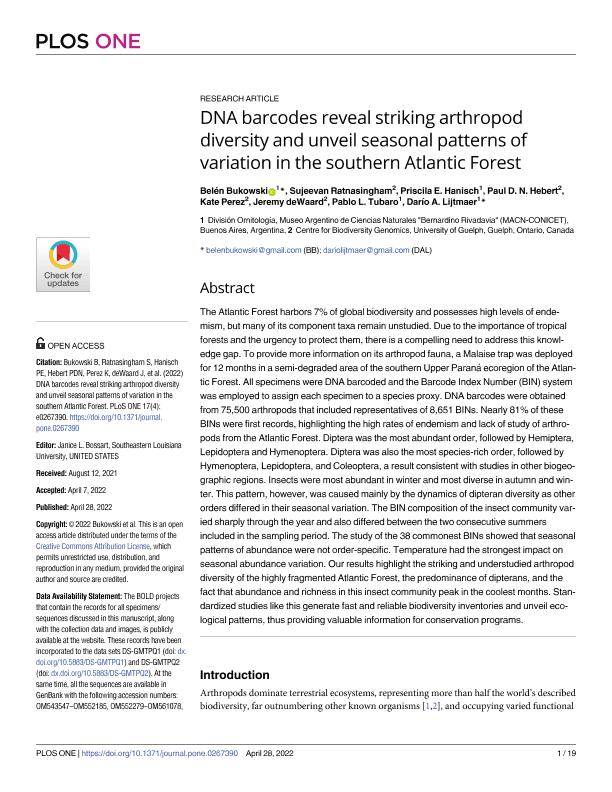Artículo
DNA barcodes reveal striking arthropod diversity and unveil seasonal patterns of variation in the southern Atlantic Forest
Bukowski Loináz, María Belén ; Ratnasingham, Sujeevan; Hanisch, Priscila Elena
; Ratnasingham, Sujeevan; Hanisch, Priscila Elena ; Hebert, Paul D. N.; Perez, Kate; deWaard, Jeremy; Tubaro, Pablo Luis
; Hebert, Paul D. N.; Perez, Kate; deWaard, Jeremy; Tubaro, Pablo Luis ; Lijtmaer, Dario Alejandro
; Lijtmaer, Dario Alejandro
 ; Ratnasingham, Sujeevan; Hanisch, Priscila Elena
; Ratnasingham, Sujeevan; Hanisch, Priscila Elena ; Hebert, Paul D. N.; Perez, Kate; deWaard, Jeremy; Tubaro, Pablo Luis
; Hebert, Paul D. N.; Perez, Kate; deWaard, Jeremy; Tubaro, Pablo Luis ; Lijtmaer, Dario Alejandro
; Lijtmaer, Dario Alejandro
Fecha de publicación:
04/2022
Editorial:
Public Library of Science
Revista:
Plos One
ISSN:
1932-6203
Idioma:
Inglés
Tipo de recurso:
Artículo publicado
Clasificación temática:
Resumen
The Atlantic Forest harbors 7% of global biodiversity and possesses high levels of endemism, but many of its component taxa remain unstudied. Due to the importance of tropical forests and the urgency to protect them, there is a compelling need to address this knowledge gap. To provide more information on its arthropod fauna, a Malaise trap was deployed for 12 months in a semi-degraded area of the southern Upper Paraná ecoregion of the Atlantic Forest. All specimens were DNA barcoded and the Barcode Index Number (BIN) system was employed to assign each specimen to a species proxy. DNA barcodes were obtained from 75,500 arthropods that included representatives of 8,651 BINs. Nearly 81% of these BINs were first records, highlighting the high rates of endemism and lack of study of arthropods from the Atlantic Forest. Diptera was the most abundant order, followed by Hemiptera, Lepidoptera and Hymenoptera. Diptera was also the most species-rich order, followed by Hymenoptera, Lepidoptera, and Coleoptera, a result consistent with studies in other biogeographic regions. Insects were most abundant in winter and most diverse in autumn and winter. This pattern, however, was caused mainly by the dynamics of dipteran diversity as other orders differed in their seasonal variation. The BIN composition of the insect community varied sharply through the year and also differed between the two consecutive summers included in the sampling period. The study of the 38 commonest BINs showed that seasonal patterns of abundance were not order-specific. Temperature had the strongest impact on seasonal abundance variation. Our results highlight the striking and understudied arthropod diversity of the highly fragmented Atlantic Forest, the predominance of dipterans, and the fact that abundance and richness in this insect community peak in the coolest months. Standardized studies like this generate fast and reliable biodiversity inventories and unveil ecological patterns, thus providing valuable information for conservation programs.
Palabras clave:
ATLANTIC FOREST
,
DNA BARCODES
,
MALAISE TRAP
,
ARTHROPOD DIVERSITY
Archivos asociados
Licencia
Identificadores
Colecciones
Articulos(MACNBR)
Articulos de MUSEO ARG.DE CS.NAT "BERNARDINO RIVADAVIA"
Articulos de MUSEO ARG.DE CS.NAT "BERNARDINO RIVADAVIA"
Citación
Bukowski Loináz, María Belén; Ratnasingham, Sujeevan; Hanisch, Priscila Elena; Hebert, Paul D. N.; Perez, Kate; et al.; DNA barcodes reveal striking arthropod diversity and unveil seasonal patterns of variation in the southern Atlantic Forest; Public Library of Science; Plos One; 17; 4; 4-2022; 1-19
Compartir
Altmétricas



